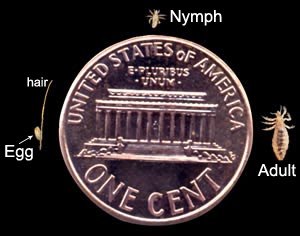Lice
Helpful Information Regarding Head Lice
What exactly are head lice? Head lice (pediculus humanus capitis) are tiny, pale gray insects about the size of a sesame seed (2–3 mm long). One “lice” is a louse, and it only takes two to infest the scalp since newly hatched eggs reach adulthood in 12 days and begin laying their own eggs. If left untreated, this cycle can repeat every three weeks. The eggs and their shell casings are “nits” and are easily visible with the naked eye. A sticky substance secreted when the lice lay the eggs attaches the yellowish or white tiny ovals (about 0.8 x 0.3 mm) on the hair shafts near the roots and holds them firmly in place.
How do lice spread? Head lice spread through close, personal contact with the hair of a person infested and the sharing of items such as combs, brushes, hats, sleeping bags, etc. Advise your children against sharing hair tools and clothing. Lice cannot jump, hop, or fly; they can only crawl. Animals are not a source of human head lice.
What are the symptoms of head lice? The most common symptom when suspecting head lice is itching and scratching behind the ears and at the back of the neck. It may take up to 4 weeks after lice get on the scalp for the itching to begin, and the itching can last for weeks, even after treatment. However, an itchy scalp also may be due to eczema, dandruff, or an allergy to hair products.
How do you check for head lice? According to the American Academy of Pediatrics (AAP), regular checks for head lice at home are a good way to spot lice before they have time to multiply and infest your child’s scalp.
Seat your child in a brightly lit room.
Part the hair with a comb and look at your child’s scalp. Start at the bottom of the neck and work your way up and along the sides. The easiest place to find them is at the hairline at the back of the neck or behind the ears.
Look for crawling lice and nits. Lice avoid light and move quickly. Nits look like small white or yellow/brown specks attached to the hair near the scalp. Nits look somewhat like dandruff, dirt particles, or hair spray droplets. The difference is that nits stick to the hair shaft and can’t be moved, while dandruff, dirt, or other particles will move easily.
What do I do if I find lice?
Treatment for head lice is recommended for persons diagnosed with an active infestation.
The diagnosis of head lice infestation is best made by finding a live nymph or adult louse on the scalp or hair of a person. If crawling lice are not seen, finding nits attached firmly within ½” of the base of the hair suggests, but does not confirm, the person is actively infested.
All household members should be checked. All infested household members and close contacts and their bedmates should be treated at the same time.
Both prescription and over the counter remedies are effective in treating head lice. There are also businesses and hair dressers that will treat lice. Please follow the directions on the packaging. After treatment, checking the hair and combing with a nit comb to remove nits and head lice every 1-2 days may decrease the chance of self-reinfestation. Continue to check hair for 2-3 weeks to be sure all head lice and nits are gone.
Machine wash and dry clothing, coats, hats, bed linens, and other items that the person who was infested wore or used during the 2 days before treatment using the hot water laundry cycle and the high heat drying cycle. Clothing and items that are not washable can be dry-cleaned OR sealed in a plastic bag and stored for 2 weeks.
Soak combs and brushes in hot water for 5-10 minutes.
Vacuum the floor, furniture and car, particularly where the person with lice has recently sat or lay.
What else do I need to know about head lice?
“Getting head lice” is not related to cleanliness of the person or his or her environment.
Head lice do not transmit communicable diseases.
Head lice survive less than 1-2 days if they fall off a person and cannot feed; nits cannot hatch and usually die within a week if they are not kept at the same temperature as that found close to the human scalp.
Animals are not a source of human head lice.
Do not use fumigant sprays; they can be toxic if inhaled or absorbed through the skin.
A child can return to school after receiving treatment for head lice.
Please notify the health office of the treatment medicine used. We will monitor your child for possible re-infestation.

Photo for identification and sizing purposes
